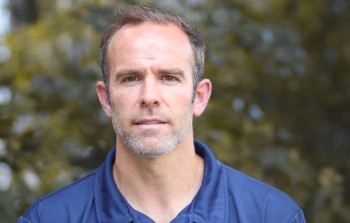Four questions with Alex Chiet
 Alex Chiet left a promising career in Canadian sports to become a national consultant for Sport New Zealand, and arrived just in time to be a catalyst for a shake-up of the country’s five largest youth sport organizations. As a champion of fun and inclusion, he’s been overseeing a culture shift that will change the face of Kiwi sport for years to come. Sport for Life reached out to him to see if his successes could be replicated in a Canadian context.
Alex Chiet left a promising career in Canadian sports to become a national consultant for Sport New Zealand, and arrived just in time to be a catalyst for a shake-up of the country’s five largest youth sport organizations. As a champion of fun and inclusion, he’s been overseeing a culture shift that will change the face of Kiwi sport for years to come. Sport for Life reached out to him to see if his successes could be replicated in a Canadian context.
#1. You’re a big believer in holistic development, and in media interviews you’ve expressed your dissatisfaction with the status quo when it comes to youth sport. As part of your initiative Balance is Better, organizations would prioritize fun, socializing and inclusion rather than continuing with an emphasis on competition. At what point in your career did you realize this shift was necessary and why?
This shift has evolved as I have gained more experience and learnings from viewing the sport system from different perspectives (player, coach, parent and administrator). I have also benefited from my ongoing learning being shaped by many great people I work with over the years. I think transitioning from a Sport (NGB / PSO) to working for Sport NZ (NZ Government) I have a greater responsibility to consider the wider sport system.
At Sport NZ, we are fortunate to have access to information and insights that allow you to reflect and bring great minds together to work on collective opportunities. It is quite easy to get caught up in the part of the sport system you work in — performance pathways, for example — and not see the unintended consequences of the programs on other parts of the sport system, such as participation pathways. Through consultation with our partner organisations developing the Sport NZ Talent Plan (“Balance is better”) back in 2015, this became increasingly apparent.
The more we worked with and listened to our sports leaders, the more we realized that the challenges were identical, just in a different context. In the last few years that has translated to participation numbers in sport, especially for our rangatahi (youth 11-18) declining. The performance behaviours are creeping at an alarming rate further down into youth sport and this is having a negative impact on the quality of the sport experience for all young people. It also affects young people in sport from reaching their potential as senior athletes. Now that we have the data and the evidence is clear, we need to influence a culture shift and change behaviours. We are pleased to be making progress.
#2. The five sports that have signed on for this culture shift are cricket, football, hockey, netball and rugby. In one editorial, Dr. Nicholas Rowe wrote that the penchant for competition has historically ruined dance for many participants as well. What other sport organizations do you have your sights set on, and how do you plan to engage them?
Yes, we began working more directly with five of our largest participation sports 15 months ago. This was based on learnings from earlier pilot projects where it became clear that sports needed a few key ingredients to influence this change, such as strategic alignment, leadership support and membership structures with the capability and capacity. While it was a tough decision at the time especially for other sports, we felt we would have more impact working with a smaller group of sports in the early stages to influence change.
We wanted to set the bar high and ensure that the actions from the sports (i.e. removing representative programs, offering new participation opportunities) were real and not just words. The sports had to honestly reflect themselves. Many would like to change their programs and structures, but could they actually do it? When we started to get traction, the intention was for the progress to spill over to benefit other sports. We would then bring them into the program and invite them to make the same commitments to change that the five sports had.
If our larger participation sports with more resources and capacity could not lead this change, it was unlikely others sports ever could in the resource-stretched sport system we work in. That is exactly what has happened. We are shortly going to announce five new sports that have signed the collective statement of intent and Sport NZ will start to support them with the capability and leadership needed to tackle change. Even though other sports (outside of the 10) have not signed the statement of intent, they can still get behind the campaign and carry the messages. It has actually been amazing to see our leaders within the sports unite in this project, to see them prioritize this collaborative work. They are acknowledging the greater good this will create for our tamariki and rangatahi (kids and youth) and our sport system. This has certainly been a highlight for me. We are by no means there yet, though.
We have a long journey ahead, but we are making some very encouraging progress.
#3. Before heading to New Zealand in 2014, you worked in the Canadian youth soccer world. Though you accomplished many great things during your time there, you didn’t see the enthusiastic uptake you’re now experiencing elsewhere. What do you think Canadian sport organizations could do to keep pace with the rest of the world, and what is currently holding them back?
When I reflect on my time in Canada with Soccer Ontario and the wider sport system, I look back with fond memories. A huge component of the sporting sector revolves around relationships. We really are in the people business and I was privileged to meet some wonderful people and make some great friends that I will continue to stay in contact with. To be honest, I have lost touch with what is happening on the ground today in Canadian sport because my focus has remained within NZ. I do however recall great people, great thought leadership, and frameworks, tools and resources at national, provincial and local levels. There are many things that Canadians do much better than us down here in NZ.
The areas I recall being challenging during my time included:
1) The multitude of layers in Canadian sports system (NGB, PSO, Districts, Clubs) and that each have their own decision-making structures pose challenges to creating alignment in terms of collective vision and action. I recall reading some great documents and frameworks with an appetite for collaboration, but I did not see that always translating to action on the ground in provinces, districts or clubs around the country. That is both within a particular sport and sports working together in more local or district settings. It is always a challenge striking the right balance between carrot (education) and stick (legislation) to create the environment for genuine collaboration that leads to new ways of working.
2) The lure and total immersion in society of professional sport is a challenge in Canada / North America. We have the same challenges here in NZ but professional sport is still in its infancy. I recall the saturation of the sport / entertainment world has an impact on what parents / coaches / administrators think is in the best interest of the kids. Kids are not mini-adults or high performance athletes. They require different programs to meet their developmental needs. Every young person should get a quality sporting experience regardless of gender, ability, talent. I think the pendulum swinging back towards valuing physical activity and sport provides for our wellbeing, rather than sport for sport’s sake and the overemphasis on competition / performance that leads to many young people falling out of love with sport and exercise for life.
#4. If you could provide one piece of advice for the next generation of sport coaches and other sport leaders in Canada, what would you think is the most important component that needs to be amplified in youth sport?
Do not lose sight of the human element of sport. Sport is about people and connections whether you are a coach or leader. No one has all the answers, no one gets everything right and the projects that I have seen or been fortunate to be involved in have always involved multiple minds and different perspectives. Please keep what is best for young people at the centre of any decision-making process and consider the bigger picture of the true value of sport and what it provides to society in terms of wellbeing, connections, leadership, teamwork, physical and mental health. We need to work harder together to change the measures of success in youth sport.

